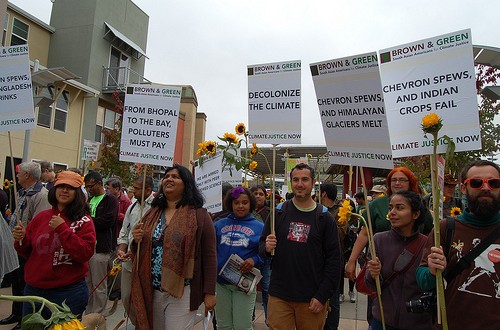By Jennifer Chang
Barnali Ghosh, coordinator and co-founder of South Asian Americans for Climate Justice, a volunteer group in the San Francisco Bay area, said that in the last five years, she has become more aware of global climate issues that affect South Asians. Ghosh said that the U.S. is one of the biggest polluting countries in the world, and she linked global warming and climate change to floods in South Asian countries.

“We have roots in Bangladesh and India, which will have to face the worst effects of climate change,” said Ghosh. “We are more aware of the increase of natural disasters and floods in Pakistan and India, and the slow erosion of people’s livelihoods because of climate change,” Ghosh said.
That is why her organization, which was established in September 2014, seeks to create awareness of how climate change has both global and local impacts on people’s livelihoods.
South Asian Americans for Climate Justice supports the work of local environmental organizations, and works with other South Asian organizations, such as Sikhs for Climate Justice and EcoSikh, and a multi-ethnic coalition of groups on local and global environmental issues. Ghosh said that regardless of the nationalities of the environmental activists, the environmental impacts, such as flooding in Bangladesh and typhoons in the Philippines, are all related and interconnected by climate change.
In fact, Ghosh said she was inspired by Filipino American organizations that have raised the issue of climate change and typhoons in the Philippines and built a grassroots movement on climate justice. The Filipino/American Coalition for Environmental Solidarity, Filipino Advocates for Justice, and the Philippine Movement for Climate Justice have organized several climate justice campaigns to raise awareness and explore climate solutions.
In fact, global climate change is predicted to overwhelmingly affect Asian countries. A study by Climate Central states that the top ten of the most at-risk countries are China, Vietnam, Japan, India, Bangladesh, Indonesia, Thailand, and the Philippines, in terms of the largest population that will be exposed to sea level rise and coastal flooding. More than 50 million people in China and 23 million in Vietnam, or 26 percent of that country’s population, will be exposed to high sea levels and flooding by the end of the century, according to the study. In South Asian countries, 12.6 million Indians and 10.2 million Bangladeshis are estimated to be directly affected by rising waters, the study stated. Nearly six million people in the Philippines, or seven percent of the population, will also be exposed.
“A lot of us are immigrants and emotionally connected to our homelands,” said Ghosh, referring to the South Asian environmental groups in the Bay area. Interest in the well-being of those homelands may be why South Asian Americans have been drawn to climate change issues for the past several years.
At the same time, Ghosh pointed to the overall importance of environmental issues among Asian Americans.
According to the National Asian American Survey of 2012, 71% of Asian Americans consider themselves environmentalist, more than 30 points higher than the national average. Higher proportions of Chinese and Vietnamese respondents self-identified as environmentalists, at 76% and 78%, respectively.
Asian Americans and Pacific Islanders are significantly more likely than the national average to prioritize environmental protection over economic growth. Sixty percent of Asian Americans prioritize environmental protection over economic growth, compared to the national average of 41% of all Americans. This sentiment is especially strong among young adults between 18 and 34, and among Indian Americans (72%), Japanese Americans (67%), and Korean Americans (67%), according to the National Asian American Survey.
Asian American communities have actively participated in the environmental justice movements across the country. In her research, Julie Sze, Associate Professor and Director of American Studies at University of California at Davis, detailed how environmental justice activists in Boston’s Chinatown and Philadelphia’s Chinatown secured self-representation in crucial environmental decision-making. Through community mobilization and protest and asserting political pressure on higher-level government officials, these activists were able to prevent commercial and other development projects from encroaching upon Chinatown residents in Boston and Philadelphia.
Another example of significant Asian American activism in environmental issues is the work that Asian Pacific Environmental Network has done in Richmond, California.

the largest such event in history. Photo from brownandgreen.org
Last August, over two dozen members of South Asian Americans for Climate Justice marched through the streets of Richmond, California to the gates of the Chevron refinery. Over 2,500 people, including numerous environmental justice groups, marched to the gates of the Chevron refinery on the first anniversary of the explosion that happened in Richmond, California, in August 2012, which sent thousands of people to the hospital with respiratory illnesses.
The Asian Pacific Environmental Network (APEN) has worked with the Laotian community to advocate for tighter safety controls around the Chevron refinery. A large immigrant and refugee Laotian community lives across the Chevron refinery in Richmond. They had complained about rashes and lung issues, which APEN later connected to their proximity to the Chevron refinery.
APEN has been successful at organizing low-income, Laotian refugee populations around environmental issues, such as the Chevron refinery, Sze said.
“We provide in-language education about the refinery and their health, and work with them about solutions,” said Parin Shah, who leads APEN’s communications and policy work. APEN provides education and information in multiple languages, including Mandarin and Cantonese.
APEN was established 21 years ago after the first People of Color Summit on the environment. “Our founders thought there were networks of Latinos and African Americans working on environmental justice, but there was no Asian American network at that time,” Shah said. The mission of APEN was thus to move Asian Americans toward environmental issues, he said.
“We care about our families and opportunities for our children,” Shah said. “We see the environment as part of that.”
 Asian Fortune Your source for all things Asian American
Asian Fortune Your source for all things Asian American



